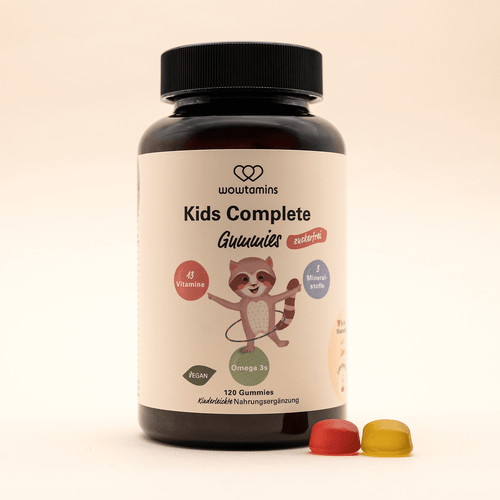Themen dieses Blogartikels:
What is vitamin C?
Vitamin C is a water-soluble vitamin. The medical name, which you will also find on the back of the packaging of food supplements, is ascorbic acid.
What are the functions of vitamin C?
Vitamin C is an important prerequisite for the formation of connective tissue (collagen synthesis) and is also a powerful antioxidant.1 Ascorbic acid supports the immune system in its defense against pathogens and is present in high concentrations in white blood cells in particular.2 It is even involved in fat burning, as it contributes to the production of the fatty acid transporter L-carnitine.3 Vitamin C has many uses, whether in the formation of amino acids, the production of steroid hormones and cholesterol or the synthesis of serotonin. Vitamin C also recycles oxidized vitamin E.
What makes vitamin C unique?
Vitamin C was discovered because a lack of it can trigger the disease scurvy. Sailors used to suffer from scurvy when they were at sea for months without fresh fruit or vegetables. They came back exhausted, with soft bones, broken teeth, damaged connective tissue, skin problems and muscle atrophy.4 The solution at the time: a crate of lemons as a preventative measure, as these have a relatively long shelf life. The antioxidant or oxidative property of vitamin C is also something special: in high doses (40 to 50 g) it has an oxidative rather than antioxidative effect. In other words, in high doses it produces free radicals instead of reducing them.5 Doses of less than 10 g, on the other hand, have an antioxidant effect.
How much vitamin C do you need per day?
The German Nutrition Society (DGE) recommends the following values for vitamin C intake6:
| Alter | Vitamin C mg/day male | Vitamin C mg/Tag female | Children and teenagers |
| 4 to under 7 years | 30 | 30 |
| 7 to under 10 years | 45 | 45 |
| 10 to under 13 years | 65 | 65 |
| 13 to under 15 years | 85 | 85 |
| 15 to under 19 years | 105 | 90 |
| Adults* | ||
| 19 to under 25 years | 110 | 95 |
| 25 to under 51 years | 110 | 95 |
| 51 to under 65 years | 110 | 95 |
| 65 years und älter | 110 | 95 |
| Pregnant women | ||
| from 4th month | 105 | |
| Breastfeeding | 125 |
* Smokers 155 mg/day (men) and 135 mg/day (women)
When do you need vitamin C most?
In phases of high stress and with increased energy requirements, vitamin C protects against the oxidative stress associated with this.7 Smokers have an increased requirement due to metabolic losses: Their turnover of vitamin C is 40% higher compared to non-smokers.8
How does an vitamin C deficiency develop and how does it manifest itself?
Vitamin C deficiency is rare in industrialized countries. This is because the reference values recommended by the German Nutrition Society can be easily achieved through a balanced diet. A deficiency mainly occurs with an extremely unbalanced diet or if the requirement is increased. This is the case, for example, for smokers, pregnant women, breastfeeding mothers and those taking certain medications. Possible health consequences include joint pain, bleeding gums, oedema and delayed wound healing.9
What happens if there is an overdose of vitamin C?
Up to an upper limit of 2,000 milligrams per day, vitamin C is not considered toxic for healthy adults. An overdose can lead to gastrointestinal problems such as nausea or diarrhea.10
Which foods are particularly high in vitamin C?
This vitamin is found in many types of fruit and vegetables. Red peppers, Brussels sprouts, kale, acerola, rose hips, sea buckthorn and blackcurrants contain particularly high levels of ascorbic acid. The myth that citrus fruits in particular contain a lot of vitamin C still persists. In fact, 100 grams of citrus fruits only contain around a third of the amount of vitamin C compared to 100 grams of red peppers.11
This dictionary entry is based on carefully researched sources:
Bibliography & Sources
- deutsche-apotheker-zeitung.de/daz-az/2008/daz-6-2008/vitamin-c-als-antioxidans-unverzichtbar
- arzt-bruchkoebel.de/infusions/
- drpetrabracht.de/blog/grippe-gesundheit-immunsystem/vitamin-c-deshalb-ist-es-so-important/
- msdmanuals.com/de-de/heim/ern%C3%A4hrungsst%C3%B6rungen/vitamins/vitamin-c-deficiency
- dr-drees.de/vitamin-c-infusions/
- dge.de/science/reference values/vitamin-c/
- imd-berlin.de/fachinformation/diagnostikinformation/oxidativer-stress-rationelle-labordiagnostik
- dge.de/gesunde-ernaehrung/faq/vitamin-c/
- netdoktor.de/laborwerte/vitamin-c/lack/
- msdmanuals.com/de-de/heim/ern%C3%A4hrungsst%C3%B6rungen/vitamins/vitamin-c-%C3%BCsurplus

















